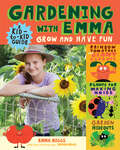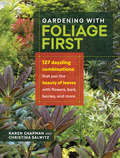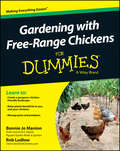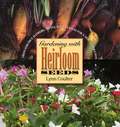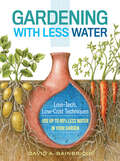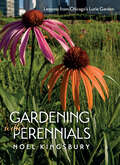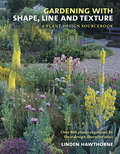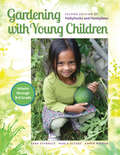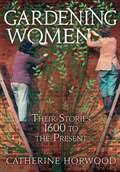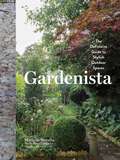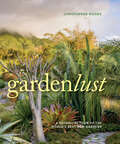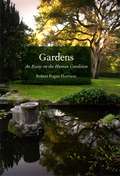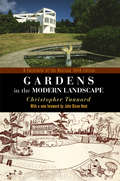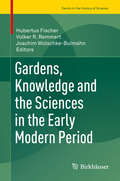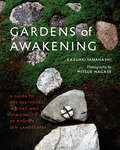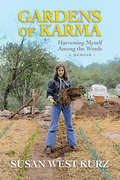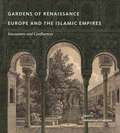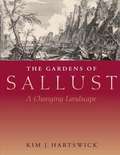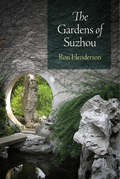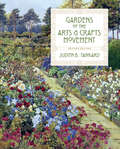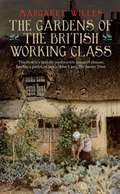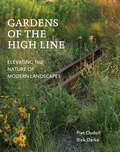- Table View
- List View
Gardening with Emma: Grow and Have Fun: A Kid-to-Kid Guide
by Emma Biggs Steven BiggsThirteen-year-old Emma Biggs is passionate about gardening and eager to share her passion with other kids!Gardening with Emma is a kid-to-kid guide to growing healthy food and raising the coolest, most awesome plants while making sure there’s plenty of fun. With plants that tickle and make noise, tips for how to grow a flower stand garden, and suggestions for veggies from tiny to colossal, Emma offers a range of original, practical, and entertaining advice and inspiration. She provides lots of useful know-how about soil, sowing, and caring for a garden throughout the seasons, along with ways to make play spaces among the plants. Lively photography and Emma’s own writing (with some help from her gardening dad, Steve) capture the authentic creativity of a kid who loves to be outdoors, digging in the dirt. This publication conforms to the EPUB Accessibility specification at WCAG 2.0 Level AA.
Gardening with Foliage First: 127 Dazzling Combinations that Pair the Beauty of Leaves with Flowers, Bark, Berries, and More
by Karen Chapman Christina SalwitzCreate a foliage-driven garden that dazzles! Although seductive, flowers, by their fleeting nature, are a fickle base to provide long-lasting gardens with year-round interest. Tackle this problem with the advice in Gardening with Foliage First. Learn how to first build a framework of foliage and then layer in flowers and other artistic elements as the finishing touches. This simple, recipe-style approach to garden design features 127 combinations for both sunny and shady gardens that work for a variety of climates and garden challenges.
Gardening with Free-Range Chickens For Dummies
by Bonnie Jo Manion Robert T. LudlowMaintain a beautiful garden with chickens? Easy.Chickens are great gardening assistants, with lots of benefits for a home garden and landscape--from soil-building to managing pests and weeds. Home gardens can be great chicken habitats if designed well, and Gardening with Free-Range Chickens For Dummies provides a plain-English guide with step-by-step guidance for creating a gorgeous chicken-friendly landscape that helps the chickens and the garden thrive. Gardening with Free-Range Chicken For Dummies offers guidance and step-by-step instructions for designing and implementing a host of different chicken garden plans. Plus, you'll get detailed information on the best plants and landscaping materials for your chicken garden (and the ones to avoid), seasonal considerations, attractive fencing options, predator and pest control, and much more. An excellent supplement to Raising Chickens For Dummies and Building Chicken Coops For DummiesA plain-English guide with step-by-step guidance for creating a chicken gardenAdvice on how to manage chickens while maintaining a beautiful gardenIf you're looking for step-by-step advice on building a chicken garden, Gardening with Free-Range Chickens For Dummies has you covered.
Gardening with Heirloom Seeds
by Lynn CoulterHeirloom seeds are more than the promise of next summer's crookneck squash or jewel-colored zinnias. They're living antiques handed down from one generation to the next, a rich inheritance of flavor and beauty from long ago and, often, far away. They are sometimes better adapted to pests and harsh conditions than many modern varieties and often simply smell or taste better. Gardening with Heirloom Seeds serves as a resource for gardeners, cooks, and plant lovers of all levels of expertise who want to know more about finding, sharing, and propagating the seeds of heirloom flowers, fruits, and vegetables. In these beautifully illustrated pages, Lynn Coulter describes fifty treasured heirloom species, from Frenchman's Darling, a flowering herb whose seeds were pocketed by Napoleon Bonaparte when he invaded Egypt in 1798, to Snow White beets, an old Dutch favorite that will not stain the cook's fingers red. Most of the plants included here will grow all across the United States; a few are best suited for warmer climates. The text is sprinkled throughout with practical advice from heirloom gardeners and lists sources for finding the seeds of many old varieties. Because it also provides ample room for making notes, Gardening with Heirloom Seeds can be used year after year and can become an heirloom in its own right--a personal journal to pass along to the next generation of gardeners.
Gardening with Less Water: Low-Tech, Low-Cost Techniques; Use up to 90% Less Water in Your Garden
by David A. BainbridgeAre you facing drought or water shortages? Gardening with Less Water offers simple, inexpensive, low-tech techniques for watering your garden much more efficiently — using up to 90 percent less water for the same results. With illustrated step-by-step instructions, David Bainbridge shows you how to install buried clay pots and pipes, wicking systems, and other porous containers that deliver water directly to a plant&’s roots with little to no evaporation. These systems are available at hardware stores and garden centers; are easy to set up and use; and work for garden beds, container gardens, and trees.
Gardening with Perennials: Lessons from Chicago's Lurie Garden
by Noel KingsburyFor gardeners, inspiration can come from the most unexpected places. Perennial enthusiasts around the world might be surprised to find their muse in the middle of a bustling city. Lurie Garden, a nearly three-acre botanic garden in the center of Chicago's lakefront in Millennium Park, is a veritable living lab of prairie perennials, with a rich array of plant life that both fascinates and educates as it grows, flowers, and dies back throughout the year. Thousands of visitors pass through each year, and many leave wondering how they might bring some of the magic of Lurie to their own home gardens. With Gardening with Perennials horticulturalist and garden writer Noel Kingsbury brings a global perspective to the Lurie oasis through a wonderful introduction to the world of perennial gardening. He shows how perennials have much to offer home gardeners, from sustainability-perennials require less water than their annual counterparts-to continuity, as perennials' longevity makes them a dependable staple. Kingsbury also explains why Lurie is a perfect case study for gardeners of all locales. The plants represented in this urban oasis were chosen specifically for reliability and longevity. The majority will thrive on a wide range of soils and across a wide climatic range. These plants also can thrive with minimal irrigation, and without fertilizers or chemical control of pests and diseases. Including a special emphasis on plants that flourish in sun, and featuring many species native to the Midwest region, Gardening with Perennials will inspire gardeners around the world to try Chicago-style sustainable gardening.
Gardening with Shape, Line and Texture: A Plant Design Sourcebook
by Linden HawthorneGardening with Shape, Line and Texture bridges the gap between garden design books and plant reference encyclopedias. Leading landscaper Linden Hawthorne looks at plants from a designer's perspective (where color is often a secondary consideration) and emphasizes the important roles of plant shape. Part One reviews fine art principles and shows how they can be successfully applied to plant compositions by grouping plants into three heights: ground to knee, knee to navel, and navel to crown. She identifies different plant shapes—buns, mounds, tiers, fountains, uprights—and shows how the use of them contributes to the success of the finished design. Part Two is a plant sourcebook with plants listed alphabetically within their key plant shape categories. This innovative plant reference delivers plant information in a form that neatly dovetails with the garden design process and will inspire gardeners to look beyond color and begin to appreciate the whole plant.
Gardening with Young Children
by Karen Midden Sara Starbuck Marla OlthofExplore the unique and expansive learning opportunities offered by gardening with childrenGardens are where children's imaginations engage nature, and the result is joyful learning. Gardening helps children develop an appreciation for the natural world and build the foundation for environmental stewardship. This book is packed with information and inspiration to help you immerse children in gardening and outdoor learning experiences-green thumb or a perfect plot of land not required.Learn how a gardening curriculum supports learning and development across all domains. You'll also find heaps of suggestions for planning, planting, and caring for a garden suited to your unique setting, such as container gardens, raised beds, in-ground gardens, gardens grown vertically on a wall or fence, and even rooftop gardens.Cultivate children's wonder and appreciation for nature. This book providesMore than 60 hands-on learning activities for children of all ages to explore plants and garden creaturesVibrant photographs and classroom stories describing showcasing great programs from around the countryNew content reflecting childhood issues and gardening trends that have surfaced in recent years, including concerns that children are becoming alienated from nature, and that childhood obesity is becoming an epidemicResources to help your garden flourish, seed and garden supply lists, information on poisonous plants, and books about gardens and garden creatures
Gardening Without Irrigation: or Without Much, Anyway
by Steve SolomonHighly informative book on gardening in arid areas.
Gardening Women: Their Stories From 1600 to the Present
by Dr Catherine HorwoodFrom Flora, Roman goddess of plants, to today's gardeners at Kew, women have always gardened. Women gardeners have grown vegetables for their kitchens and herbs for their medicine cupboards. They have been footnotes in the horticultural annals for specimens collected abroad. They taught young women about gardening twenty-five years before women's horticultural schools officially existed. And their influence on the style of our gardens, frequently unacknowledged, survives to the present day.From these triumphs to the battles fought against male-dominated institutions, from the horticultural pioneers to the bringers of change in society's attitudes, this book is a celebration of the best of the species -- gardening women.
Gardenista: The Definitive Guide to Stylish Outdoor Spaces (Remodelista)
by Michelle SlatallaNamed a Best Gift Book for Gardeners by The New York Times Book Review, Los Angeles Times, San Francisco Chronicle, Seattle Times, Domino magazine, and Goop. The team behind the inspirational design sites Gardenista.com and Remodelista.com presents an all-in-one manual for making your outdoor space as welcoming as your living room. Tour personality-filled gardens around the world and re-create the looks with no-fail planting palettes. Find hundreds of design tips and easy DIYs, editors&’ picks of 100 classic (and stylish) objects, a landscaping primer with tips from pros, over 200 resources, and so much more.
Gardenlust: A Botanical Tour of the World's Best New Gardens
by Christopher Woods“A beautiful tour through some of the loveliest gardens in the world!” —Peter H. Raven, President Emeritus at Missouri Botanical Garden A steep hillside oasis in Singapore, a garden distinguished by shape and light in Marrakech, a haunting tree museum in Switzerland—these are just a few of the extraordinary outdoor havens visited in Gardenlust. In this sumptuous global tour of modern gardens, intrepid plant expert Christopher Woods spotlights 50 modern gardens that push boundaries and define natural beauty in significant ways. Featuring both private and public gardens, this journey makes its way from the Americas and Europe to Australia and New Zealand, with stops in Asia, Africa, and the Arabian Peninsula. Along the way, you'll learn about the people, plants, and stories that make these iconic gardens so lust-worthy. As inspiring as it is insightful, Gardenlust will delight your passion for garden inspiration—and the many places it grows.
Gardens: An Essay on the Human Condition
by Robert Pogue HarrisonHumans have long turned to gardens -- both real and imaginary -- for sanctuary from the frenzy and tumult that surrounds them. Those gardens may be as far away from everyday reality as Gilgamesh's garden of the gods or as near as our own backyard, but in their very conception and the marks they bear of human care and cultivation, gardens stand as restorative, nourishing, necessary havens. With "Gardens", Robert Pogue Harrison graces readers with a thoughtful, wide-ranging examination of the many ways gardens evoke the human condition. Moving from from the gardens of ancient philosophers to the gardens of homeless people in contemporary New York, he shows how, again and again, the garden has served as a check against the destruction and losses of history.
Gardens in the Modern Landscape: A Facsimile of the Revised 1948 Edition (Penn Studies in Landscape Architecture)
by Christopher TunnardBetween 1937 and 1938, garden designer Christopher Tunnard published a series of articles in the British Architectural Review that rejected the prevailing English landscape style. Inspired by the principles of Modernist art and Japanese aesthetics, Tunnard called for a "new technique" in garden design that emphasized an integration of form and purpose. "The functional garden avoids the extremes both of the sentimental expressionism of the wild garden and the intellectual classicism of the 'formal' garden," he wrote; "it embodies rather a spirit of rationalism and through an aesthetic and practical ordering of its units provides a friendly and hospitable milieu for rest and recreation."Tunnard's magazine pieces were republished in book form as Gardens in the Modern Landscape in 1938, and a revised second edition was issued a decade later. Taken together, these articles constituted a manifesto for the modern garden, its influence evident in the work of such figures as Lawrence Halprin, Philip Johnson, and Edward Larrabee Barnes.Long out of print, the book is here reissued in a facsimile of the 1948 edition, accompanied by a contextualizing foreword by John Dixon Hunt. Gardens in the Modern Landscape heralded a sea change in the evolution of twentieth-century design, and it also anticipated questions of urban sprawl, historic preservation, and the dynamic between the natural and built environments. Available once more to students, practitioners, and connoisseurs, it stands as a historical document and an invitation to continued innovative thought about landscape architecture.
Gardens, Knowledge and the Sciences in the Early Modern Period
by Hubertus Fischer Volker R. Remmert Joachim Wolschke-BulmahnThis volume of proceedings primarily focuses on the outstanding contributions made by botany and the mathematical sciences to the genesis and development of early modern garden art and garden culture. The many facets of mathematical sciences and botany point to the increasingly "scientific" approach that was being adopted in garden art and garden culture in the early modern period. This development unfolds in interaction with philosophical, religious, political and social processes and beliefs. This volume strikingly shows that such processes are able to make use of the knowledge of nature manifested in gardens for various purposes. The conference that inspired this volume was jointly organized by the Leibniz Universität Hannover's Centre of Garden Art and Landscape Architecture (CGL) and the Bergische Universität Wuppertal's Interdisciplinary Centre for Science and Technology Studies (IZWT).
Gardens of Awakening: A Guide to the Aesthetics, History, and Spirituality of Kyoto's Zen Landscapes
by Kazuaki TanahashiRenowned artist Kaz Tanahashi reveals the deep, inner spiritual connections that Zen gardens can foster, with over 75 stunning full-color photos of the masterpiece gardens of Kyōto, Japan.Imagine yourself in Kyōto, Japan, gazing at an ancient temple garden. How would you contextualize what you are seeing? What is the history of this centuries-old contemplative art form of Zen gardening? What are its symbols and concepts?Richly illustrated with full-color photographs, Gardens of Awakening guides you through a series of Zen temple gardens, most of which were created from the fourteenth through seventeenth centuries. Some are teeming with plants and flowing water, while others have only rocks and sand. All share in the Zen aesthetics of awakening.Through essays and commentary on Mitsue Nagase&’s striking photographs, beloved Zen artist and translator Kazuaki Tanahashi presents the gardens in terms of seven qualities that arise from Zen practice: direct, ordinary, vigorous, gleaming, pivotal, nondual, and inexhaustible. Relating these qualities to the development of Zen culture and its influence on Japanese art, Gardens of Awakening invites you deep into the heart of Zen.
The Gardens of Emily Dickinson
by Judith Farr Louise CarterIn this first substantial study of Emily Dickinson's devotion to flowers and gardening, Judith Farr seeks to join both poet and gardener in one creative personality. She casts new light on Dickinson's temperament, her aesthetic sensibility, and her vision of the relationship between art and nature, revealing that the successful gardener's intimate understanding of horticulture helped shape the poet's choice of metaphors for every experience: love and hate, wickedness and virtue, death and immortality. Gardening, Farr demonstrates, was Dickinson's other vocation, more public than the making of poems but analogous and closely related to it. Over a third of Dickinson's poems and nearly half of her letters allude with passionate intensity to her favorite wildflowers, to traditional blooms like the daisy or gentian, and to the exotic gardenias and jasmines of her conservatory. Each flower was assigned specific connotations by the nineteenth century floral dictionaries she knew; thus, Dickinson's association of various flowers with friends, family, and lovers, like the tropes and scenarios presented in her poems, establishes her participation in the literary and painterly culture of her day. A chapter, "Gardening with Emily Dickinson" by Louise Carter, cites family letters and memoirs to conjecture the kinds of flowers contained in the poet's indoor and outdoor gardens. Carter hypothesizes Dickinson's methods of gardening, explaining how one might grow her flowers today. Beautifully illustrated and written with verve, The Gardens of Emily Dickinson will provide pleasure and insight to a wide audience of scholars, admirers of Dickinson's poetry, and garden lovers everywhere.
Gardens of Karma: Harvesting Myself Among the Weeds, A Memoir
by Susan West KurzIt Began in a Simple Garden . . . and Led to a Spiritual Path. Susan West Kurz's earliest memories began in a garden, where she nurtured herbs and colorful flowers, nibbled sun-drenched vegetables and ripe berries, and danced with her doll, Pinocchio. Later, she landed in another garden, that one in Germany, where she shaped her budding interest into a hugely successful career for international organic and natural skin care products. But for decades, Susan was steeped in another role-one of enabler, support system, and overall back-up singer to the alcoholics who were center stage in her life. The pain of that disease ultimately led her to Anthroposophy, her spiritual path, where she soon recognized she had been headed all along. On her subsequent journey to health and freedom, Susan continues to find inner peace in a garden.
Gardens of Renaissance Europe and the Islamic Empires: Encounters and Confluences (G - Reference, Information and Interdisciplinary Subjects)
by Mohammad GharipourThe cross-cultural exchange of ideas that flourished in the Mediterranean during the sixteenth and seventeenth centuries profoundly affected European and Islamic society. Gardens of Renaissance Europe and the Islamic Empires considers the role and place of gardens and landscapes in the broader context of the information sharing that took place among Europeans and Islamic empires in Turkey, Persia, and India.In illustrating commonalities in the design, development, and people’s perceptions of gardens and nature in both regions, this volume substantiates important parallels in the revolutionary advancements in landscape architecture that took place during the era. The contributors explain how the exchange of gardeners as well as horticultural and irrigation techniques influenced design traditions in the two cultures; examine concurrent shifts in garden and urban landscape design, such as the move toward more public functionality; and explore the mutually influential effects of politics, economics, and culture on composed outdoor space. In doing so, they shed light on the complexity of cultures and politics during the Renaissance.A thoughtfully composed look at the effects of cross-cultural exchange on garden design during a pivotal time in world history, this thought-provoking book points to new areas in inquiry about the influences, confluences, and connections between European and Islamic garden traditions.In addition to the editor, the contributors include Cristina Castel-Branco, Paula Henderson, Simone M. Kaiser, Ebba Koch, Christopher Pastore, Laurent Paya, D. Fairchild Ruggles, Jill Sinclair, and Anatole Tchikine.
Gardens of Renaissance Europe and the Islamic Empires: Encounters and Confluences
by Mohammad GharipourThe cross-cultural exchange of ideas that flourished in the Mediterranean during the sixteenth and seventeenth centuries profoundly affected European and Islamic society. Gardens of Renaissance Europe and the Islamic Empires considers the role and place of gardens and landscapes in the broader context of the information sharing that took place among Europeans and Islamic empires in Turkey, Persia, and India.In illustrating commonalities in the design, development, and people’s perceptions of gardens and nature in both regions, this volume substantiates important parallels in the revolutionary advancements in landscape architecture that took place during the era. The contributors explain how the exchange of gardeners as well as horticultural and irrigation techniques influenced design traditions in the two cultures; examine concurrent shifts in garden and urban landscape design, such as the move toward more public functionality; and explore the mutually influential effects of politics, economics, and culture on composed outdoor space. In doing so, they shed light on the complexity of cultures and politics during the Renaissance.A thoughtfully composed look at the effects of cross-cultural exchange on garden design during a pivotal time in world history, this thought-provoking book points to new areas in inquiry about the influences, confluences, and connections between European and Islamic garden traditions.In addition to the editor, the contributors include Cristina Castel-Branco, Paula Henderson, Simone M. Kaiser, Ebba Koch, Christopher Pastore, Laurent Paya, D. Fairchild Ruggles, Jill Sinclair, and Anatole Tchikine.
The Gardens of Sallust: A Changing Landscape
by Kim J. HartswickPleasure gardens, or horti, offered elite citizens of ancient Rome a retreat from the noise and grime of the city, where they could take their leisure and even conduct business amid lovely landscaping, architecture, and sculpture. <P><P>One of the most important and beautiful of these gardens was the horti Sallustiani, originally developed by the Roman historian Sallust at the end of the first century B.C. and later possessed and perfected by a series of Roman emperors. Though now irrevocably altered by two millennia of human history, the Gardens of Sallust endure as a memory of beauty and as a significant archaeological site, where fragments of sculpture and ruins of architecture are still being discovered.
The Gardens of Suzhou (Penn Studies in Landscape Architecture)
by Ron HendersonSuzhou, near Shanghai, is among the great garden cities of the world. The city's masterpieces of classical Chinese garden design, built from the eleventh through the nineteenth centuries, attract thousands of visitors each year and continue to influence international design. In The Gardens of Suzhou, landscape architect and scholar Ron Henderson guides visitors through seventeen of these gardens. The book explores UNESCO world cultural heritage sites such as the Master of the Nets Garden, Humble Administrator's Garden, Lingering Garden, and Garden of the Peaceful Mind, as well as other lesser-known but equally significant gardens in the Suzhou region.Unlike the acclaimed religious and imperial gardens found elsewhere in Asia, Suzhou's gardens were designed by scholars and intellectuals to be domestic spaces that drew upon China's rich visual and literary tradition, embedding cultural references within the landscapes. The elements of the gardens confront the visitor: rocks, trees, and walls are pushed into the foreground to compress and compact space, as if great hands had gathered a mountainous territory of rocky cliffs, forests, and streams, then squeezed it tightly until the entire region would fit into a small city garden.Henderson's commentary opens Suzhou's gardens, with their literary and musical references, to non-Chinese visitors. Drawing on years of intimate experience and study, he combines the history and spatial organization of each garden with personal insights into their rockeries, architecture, plants, and waters. Fully illustrated with newly drawn plans, maps, and original photographs, The Gardens of Suzhou invites visitors, researchers, and designers to pause and observe astonishing works from one of the world's greatest garden design traditions.
Gardens of the Arts and Crafts Movement: Revised Second Edition
by Judith B. TankardIn this revised edition of Gardens of the Arts and Crafts Movement, landscape scholar Judith B. Tankard surveys the inspirations, characteristics, and development of garden design during the movement. Tankard presents a selection of houses and gardens of the era from Great Britain and adds new examples from North America. With almost 300 illustrations and photographs, and an emphasis on the diversity of designers who helped forge the movement, this book is an essential resource for this truly distinct approach to garden design.
The Gardens of the British Working Class
by Margaret WillesThis magnificently illustrated people's history celebrates the extraordinary feats of cultivation by the working class in Britain, even if the land they toiled, planted, and loved was not their own. Spanning more than four centuries, from the earliest records of the laboring classes in the country to today, Margaret Willes's research unearths lush gardens nurtured outside rough workers' cottages and horticultural miracles performed in blackened yards, and reveals the ingenious, sometimes devious, methods employed by determined, obsessive, and eccentric workers to make their drab surroundings bloom. She also explores the stories of the great philanthropic industrialists who provided gardens for their workforces, the fashionable rich stealing the gardening ideas of the poor, alehouse syndicates and fierce rivalries between vegetable growers, flower-fanciers cultivating exotic blooms on their city windowsills, and the rich lore handed down from gardener to gardener through generations. This is a sumptuous record of the myriad ways in which the popular cultivation of plants, vegetables, and flowers has played-and continues to play-an integral role in everyday British life.
Gardens of the High Line: Elevating the Nature of Modern Landscapes
by Piet Oudolf Rick DarkeThe Gardens of the High Line is the first book devoted to the plants and planting design of New York City's iconic High Line. In its sumptuous pages, Piet Oudolf, who designed the original plantings, and Rick Darke, a leading voice in sustainable horticulture, reveal why the High Line is such an iconic example of landscape design.
